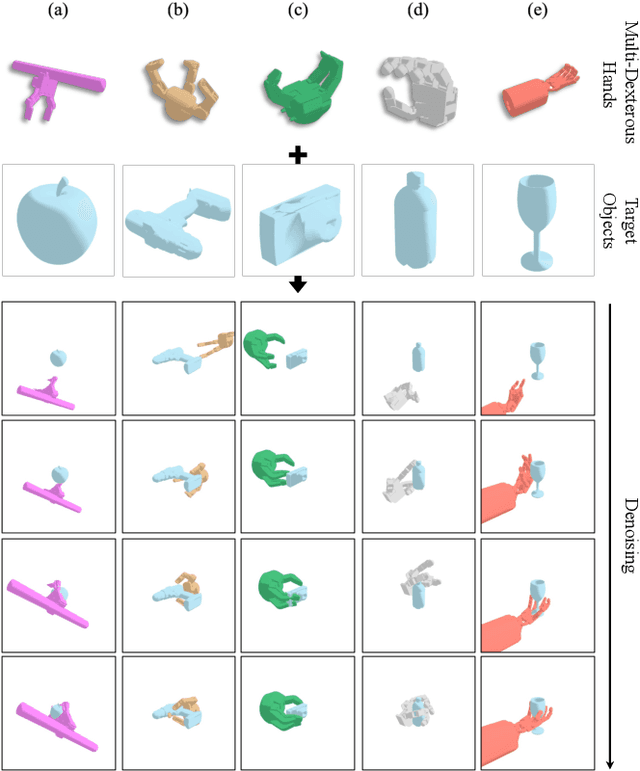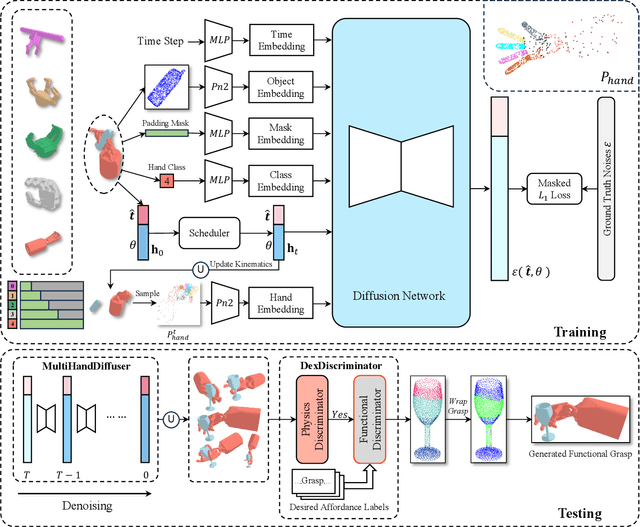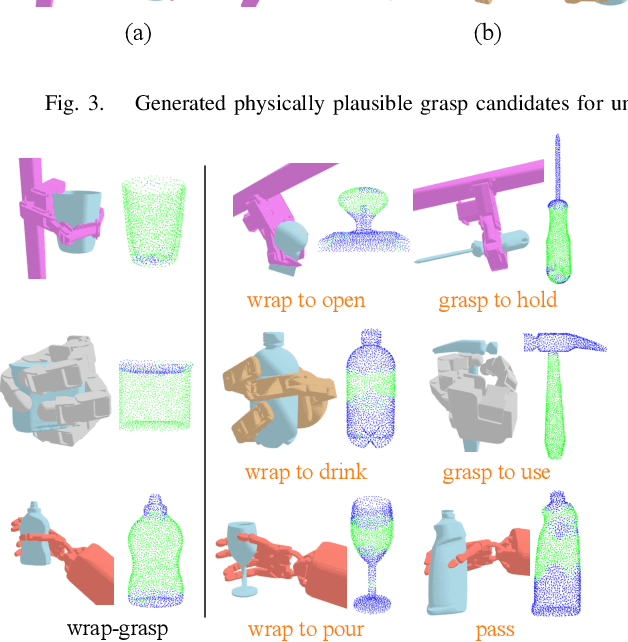Sheng Guo
A Large-Scale Study on Video Action Dataset Condensation
Dec 30, 2024Abstract:Dataset condensation has made significant progress in the image domain. Unlike images, videos possess an additional temporal dimension, which harbors considerable redundant information, making condensation even more crucial. However, video dataset condensation still remains an underexplored area. We aim to bridge this gap by providing a large-scale empirical study with systematic design and fair comparison. Specifically, our work delves into three key aspects to provide valuable empirical insights: (1) temporal processing of video data, (2) establishing a comprehensive evaluation protocol for video dataset condensation, and (3) adaptation of condensation methods to the space-time domain and fair comparisons among them. From this study, we derive several intriguing observations: (i) sample diversity appears to be more crucial than temporal diversity for video dataset condensation, (ii) simple slide-window sampling proves to be effective, and (iii) sample selection currently outperforms dataset distillation in most cases. Furthermore, we conduct experiments on three prominent action recognition datasets (HMDB51, UCF101 and Kinetics-400) and achieve state-of-the-art results on all of them. Our code is available at https://github.com/MCG-NJU/Video-DC.
FocusLLaVA: A Coarse-to-Fine Approach for Efficient and Effective Visual Token Compression
Nov 21, 2024



Abstract:Recent advances on Multi-modal Large Language Models have demonstrated that high-resolution image input is crucial for model capabilities, especially for fine-grained tasks. However, high-resolution images lead to a quadratic increase in the number of visual tokens input into LLMs, resulting in significant computational costs. Current work develop visual token compression methods to achieve efficiency improvements, often at the expense of performance. We argue that removing visual redundancy can simultaneously improve both efficiency and performance. We build a coarse-to-fine visual token compression method, with a vision-guided sampler for compressing redundant regions with low information density, and a text-guided sampler for selecting visual tokens that are strongly correlated with the user instructions.With these two modules, the proposed FocusLLaVA achieves improvements in both efficiency and performance. We validate the effectiveness of our approach on a wide range of evaluation datasets.
DexGrasp-Diffusion: Diffusion-based Unified Functional Grasp Synthesis Pipeline for Multi-Dexterous Robotic Hands
Jul 13, 2024



Abstract:The versatility and adaptability of human grasping catalyze advancing dexterous robotic manipulation. While significant strides have been made in dexterous grasp generation, current research endeavors pivot towards optimizing object manipulation while ensuring functional integrity, emphasizing the synthesis of functional grasps following desired affordance instructions. This paper addresses the challenge of synthesizing functional grasps tailored to diverse dexterous robotic hands by proposing DexGrasp-Diffusion, an end-to-end modularized diffusion-based pipeline. DexGrasp-Diffusion integrates MultiHandDiffuser, a novel unified data-driven diffusion model for multi-dexterous hands grasp estimation, with DexDiscriminator, which employs a Physics Discriminator and a Functional Discriminator with open-vocabulary setting to filter physically plausible functional grasps based on object affordances. The experimental evaluation conducted on the MultiDex dataset provides substantiating evidence supporting the superior performance of MultiHandDiffuser over the baseline model in terms of success rate, grasp diversity, and collision depth. Moreover, we demonstrate the capacity of DexGrasp-Diffusion to reliably generate functional grasps for household objects aligned with specific affordance instructions.
Edge Wasserstein Distance Loss for Oriented Object Detection
Dec 12, 2023Abstract:Regression loss design is an essential topic for oriented object detection. Due to the periodicity of the angle and the ambiguity of width and height definition, traditional L1-distance loss and its variants have been suffered from the metric discontinuity and the square-like problem. As a solution, the distribution based methods show significant advantages by representing oriented boxes as distributions. Differing from exploited the Gaussian distribution to get analytical form of distance measure, we propose a novel oriented regression loss, Wasserstein Distance(EWD) loss, to alleviate the square-like problem. Specifically, for the oriented box(OBox) representation, we choose a specially-designed distribution whose probability density function is only nonzero over the edges. On this basis, we develop Wasserstein distance as the measure. Besides, based on the edge representation of OBox, the EWD loss can be generalized to quadrilateral and polynomial regression scenarios. Experiments on multiple popular datasets and different detectors show the effectiveness of the proposed method.
StageInteractor: Query-based Object Detector with Cross-stage Interaction
Apr 11, 2023Abstract:Previous object detectors make predictions based on dense grid points or numerous preset anchors. Most of these detectors are trained with one-to-many label assignment strategies. On the contrary, recent query-based object detectors depend on a sparse set of learnable queries and a series of decoder layers. The one-to-one label assignment is independently applied on each layer for the deep supervision during training. Despite the great success of query-based object detection, however, this one-to-one label assignment strategy demands the detectors to have strong fine-grained discrimination and modeling capacity. To solve the above problems, in this paper, we propose a new query-based object detector with cross-stage interaction, coined as StageInteractor. During the forward propagation, we come up with an efficient way to improve this modeling ability by reusing dynamic operators with lightweight adapters. As for the label assignment, a cross-stage label assigner is applied subsequent to the one-to-one label assignment. With this assigner, the training target class labels are gathered across stages and then reallocated to proper predictions at each decoder layer. On MS COCO benchmark, our model improves the baseline by 2.2 AP, and achieves 44.8 AP with ResNet-50 as backbone, 100 queries and 12 training epochs. With longer training time and 300 queries, StageInteractor achieves 51.1 AP and 52.2 AP with ResNeXt-101-DCN and Swin-S, respectively.
PDPP:Projected Diffusion for Procedure Planning in Instructional Videos
Mar 26, 2023Abstract:In this paper, we study the problem of procedure planning in instructional videos, which aims to make goal-directed plans given the current visual observations in unstructured real-life videos. Previous works cast this problem as a sequence planning problem and leverage either heavy intermediate visual observations or natural language instructions as supervision, resulting in complex learning schemes and expensive annotation costs. In contrast, we treat this problem as a distribution fitting problem. In this sense, we model the whole intermediate action sequence distribution with a diffusion model (PDPP), and thus transform the planning problem to a sampling process from this distribution. In addition, we remove the expensive intermediate supervision, and simply use task labels from instructional videos as supervision instead. Our model is a U-Net based diffusion model, which directly samples action sequences from the learned distribution with the given start and end observations. Furthermore, we apply an efficient projection method to provide accurate conditional guides for our model during the learning and sampling process. Experiments on three datasets with different scales show that our PDPP model can achieve the state-of-the-art performance on multiple metrics, even without the task supervision. Code and trained models are available at https://github.com/MCG-NJU/PDPP.
Efficient Training of Large-scale Industrial Fault Diagnostic Models through Federated Opportunistic Block Dropout
Feb 22, 2023Abstract:Artificial intelligence (AI)-empowered industrial fault diagnostics is important in ensuring the safe operation of industrial applications. Since complex industrial systems often involve multiple industrial plants (possibly belonging to different companies or subsidiaries) with sensitive data collected and stored in a distributed manner, collaborative fault diagnostic model training often needs to leverage federated learning (FL). As the scale of the industrial fault diagnostic models are often large and communication channels in such systems are often not exclusively used for FL model training, existing deployed FL model training frameworks cannot train such models efficiently across multiple institutions. In this paper, we report our experience developing and deploying the Federated Opportunistic Block Dropout (FEDOBD) approach for industrial fault diagnostic model training. By decomposing large-scale models into semantic blocks and enabling FL participants to opportunistically upload selected important blocks in a quantized manner, it significantly reduces the communication overhead while maintaining model performance. Since its deployment in ENN Group in February 2022, FEDOBD has served two coal chemical plants across two cities in China to build industrial fault prediction models. It helped the company reduce the training communication overhead by over 70% compared to its previous AI Engine, while maintaining model performance at over 85% test F1 score. To our knowledge, it is the first successfully deployed dropout-based FL approach.
CoMAE: Single Model Hybrid Pre-training on Small-Scale RGB-D Datasets
Feb 13, 2023Abstract:Current RGB-D scene recognition approaches often train two standalone backbones for RGB and depth modalities with the same Places or ImageNet pre-training. However, the pre-trained depth network is still biased by RGB-based models which may result in a suboptimal solution. In this paper, we present a single-model self-supervised hybrid pre-training framework for RGB and depth modalities, termed as CoMAE. Our CoMAE presents a curriculum learning strategy to unify the two popular self-supervised representation learning algorithms: contrastive learning and masked image modeling. Specifically, we first build a patch-level alignment task to pre-train a single encoder shared by two modalities via cross-modal contrastive learning. Then, the pre-trained contrastive encoder is passed to a multi-modal masked autoencoder to capture the finer context features from a generative perspective. In addition, our single-model design without requirement of fusion module is very flexible and robust to generalize to unimodal scenario in both training and testing phases. Extensive experiments on SUN RGB-D and NYUDv2 datasets demonstrate the effectiveness of our CoMAE for RGB and depth representation learning. In addition, our experiment results reveal that CoMAE is a data-efficient representation learner. Although we only use the small-scale and unlabeled training set for pre-training, our CoMAE pre-trained models are still competitive to the state-of-the-art methods with extra large-scale and supervised RGB dataset pre-training. Code will be released at https://github.com/MCG-NJU/CoMAE.
Learning 3D-aware Image Synthesis with Unknown Pose Distribution
Jan 18, 2023Abstract:Existing methods for 3D-aware image synthesis largely depend on the 3D pose distribution pre-estimated on the training set. An inaccurate estimation may mislead the model into learning faulty geometry. This work proposes PoF3D that frees generative radiance fields from the requirements of 3D pose priors. We first equip the generator with an efficient pose learner, which is able to infer a pose from a latent code, to approximate the underlying true pose distribution automatically. We then assign the discriminator a task to learn pose distribution under the supervision of the generator and to differentiate real and synthesized images with the predicted pose as the condition. The pose-free generator and the pose-aware discriminator are jointly trained in an adversarial manner. Extensive results on a couple of datasets confirm that the performance of our approach, regarding both image quality and geometry quality, is on par with state of the art. To our best knowledge, PoF3D demonstrates the feasibility of learning high-quality 3D-aware image synthesis without using 3D pose priors for the first time.
Personalized Federated Learning for Multi-task Fault Diagnosis of Rotating Machinery
Nov 17, 2022Abstract:Intelligent fault diagnosis is essential to safe operation of machinery. However, due to scarce fault samples and data heterogeneity in field machinery, deep learning based diagnosis methods are prone to over-fitting with poor generalization ability. To solve the problem, this paper proposes a personalized federated learning framework, enabling multi-task fault diagnosis method across multiple factories in a privacypreserving manner. Firstly, rotating machines from different factories with similar vibration feature data are categorized into machine groups using a federated clustering method. Then, a multi-task deep learning model based on convolutional neural network is constructed to diagnose the multiple faults of machinery with heterogeneous information fusion. Finally, a personalized federated learning framework is proposed to solve data heterogeneity across different machines using adaptive hierarchical aggregation strategy. The case study on collected data from real machines verifies the effectiveness of the proposed framework. The result shows that the diagnosis accuracy could be improved significantly using the proposed personalized federated learning, especially for those machines with scarce fault samples.
 Add to Chrome
Add to Chrome Add to Firefox
Add to Firefox Add to Edge
Add to Edge